Matt Rees's Blog, page 44
May 3, 2009
The Writing Life interview: Alon Hilu

The most original voice in Hebrew fiction is that of Alon Hilu. His first novel “Death of a Monk” took a blood libel against the Jews of Damascus in 1840 and offered a startling alternative perspective on how the murder at the heart of the scandal might have taken place. The second of his novels “House of Dajani” will be out in English next year, but it’s already controversial in Israel. Set in 1895 it casts a different light on the early Zionist settlers of what was then Palestine, suggesting that the precursors of today’s Israelis might not have been quite so heroic. “Dajani” is set in Jaffa, where Alon was born in 1972. His parents were born in Damascus.
How long did it take you to get published?
I was first published at the age of 20 (two short stories were published in Israeli literary magazines), and my first novel, “Death of a Monk” was published when I was 32.
Would you recommend any books on writing?
“The Art of Dramatic Writing” by Lajos Egri – written originally for playwrights – gives the basics for writing, and I found it very useful. The most challenging part for me in writing is the structuring of plots, and for this particular purpose I use the book “20 Master Plots (and how to build them)” by Ronald B. Tobias, which I highly recommend.
What’s a typical writing day?
My writing discipline is very poor. I only write when I feel I want to write. It usually happens during the quiet hours of late night.
Plug your latest book. What’s it about? Why’s it so great?
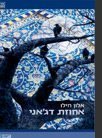
“The House of Dajani” is a gothic story about a Palestinian child who lives in Jaffa in 1895, and can see the far future, and in particular the Jewish-Arab conflict and the many wars to come. He meets a 27 year old Zionist immigrant, and their relationship begins with love, but transfers into hate, when the child accuses the Jewish adult of killing his father. The book can be read as a metaphor of the Jewish-Arab relationship in Israel during the last century, became a best seller in Israel and is being translated into five languages. I love this book because it takes the readers back to late 19th century, and describes the landscape and people of what I call “Palestinian Tel Aviv”.
How much of what you do is dictated by formula – how much is complete originality?
I always work with the same formula of plot structure, which is comprised of a triggering event, a developing conflict, a crisis and a resolution. I write the synopsis in advance and remain pretty close to it. What changes from book to book is the content poured into the structure.
What’s your favorite sentence in all literature, and why?
The first sentence of “Lolita” by Vladimir Nabokov: “Lolita, light of my life, fire of my loins. My sin, my soul. Lo-lee-ta: the tip of the tongue taking a trip of three steps down the palate to tap, at three, on the teeth. Lo. Lee. Ta”. It is poetically written, and absorbs the obsession of the narrator in few words. I also love the novel – it is undoubtedly a masterpiece.
How much research is involved in each of your books?
My first two books were historical novels, and naturally I had to invest time and energy to research the historical period and place (1840 Damascus in “Death of a Monk” and 1895 Jaffa in “The House of Dajani”). It takes me about one to two years to complete the research.
Where’d you get the idea for your main character?
From the research. I intentionally look for the forgotten characters, which are not praised by historians, and I usually have only one descriptive sentence about the character when choosing him. In my first book, the protagonist was Aslan Farhi, a 19 year old Jew from Damascus, who accused his father of killing a monk for ritual purposes. The descriptive sentence I had in mind was: “the son who falsely accused his father”. In the second novel, the main character is a 12 year old Palestinian child who foresee Zionism and the establishment of the state of Israel. The descriptive sentence of him was: “the child who could see the death of his people”.
What’s your experience with being translated?
Each of my books has been translated into five languages. Since I write in anachronistic Hebrew, it is always a challenge for my translators to depict the aroma of the Hebrew to the target language. Of my translated books, I can only read English, and I can tell that my translator, Evan Fallenberg made a terrific work in translating both books. [I interviewed Evan Fallenberg recently in The Writing Life series.--MBR]
Do you live entirely off your writing? How many books did you write before could make a living at it?
No, I work as a general counsel of a hi-tech company called Voltaire Ltd. and I make my living off being a lawyer.
How many books did you write before you were published?
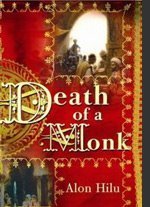
One – the one that was published (“Death of a Monk”).
What’s the strangest thing that happened to you on a book tour?
I went to downtown San Francisco to lecture at the LGBT center, and found out that the entrance was blocked by angry women. It was a contest against my lecture, held by an anti-Israeli Lesbian group based in California. They proclaimed that the LGBT should not host events sponsored by the Israeli consulate, because Israel was anti-gay (which is a ridiculous argument anyway).
What’s your weirdest idea for a book you’ll never get to publish?
No such thing – everything is worth to print.
May 1, 2009
Review: Red Hot Hurwitz
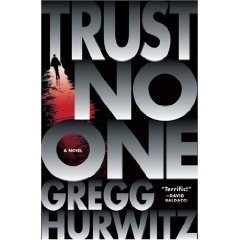
Trust No One by Gregg Hurwitz
St. Martin’s Press. To be published 23 June
The key to a first-rate thriller is for the main character to come up against a dead end many times during the book. The reader, knowing the forces arrayed against our hero and desperate to save him from more danger, each time wills him to use this excuse to abandon his quest. Of course, readers wouldn’t care at these turning points if the hero wasn’t a well-formed character whose humanity has drawn us to him, and that’s the other important element in the genre. Naturally the hero doesn’t quit, and our author takes us into the last segment of the book where the plot unravels and the twists snap us upright in our chairs.
Gregg Hurwitz fulfills all these criteria with real style in “Trust No One,” his new novel. It’d be worth reading if only for the startling denouement in which the hero battles against powerful forces – the Secret Service among others. But the drive of the book comes from the scars of his destroyed family. By the end of the book Hurwitz has tied a message of redemption into the fast-paced action.
"Trust No One" begins with Nick Horrigan catapulted out of the quiet life he’s lived for years. His stepfather, a Secret Service agent, was killed when Nick was a teen. Nick blames himself. As part of a cover-up, he was forced by other agents to go on the run. He’s been lonely and guilt-ridden for a decade. Now the Secret Service arrives through his window… and he’s not lonely any more.
A man threatening to blow up a California nuclear facility hands a key to Horrigan before he dies. As Horrigan tries to figure out what the key is for and why the man gave it to him, he’s drawn into a mystery that leads right back to his stepfather’s killing and into the upper echelons of the US political system.
Readers might detect an element of the “family at risk” sub-genre that Harlan Coben has perfected. Hurwitz does it with all the skill of Coben, but with a twist. In his rendition, the family isn’t only in need of rescue — it’s the reason for all the risk in the first place.
“Trust No One” is Hurwitz’s ninth novel, coming two years after the excellent “The Crime Writer”. He also writes for Marvel comics and is a screenwriter. Once you’ve read all his novels and comics, you might be intrigued to try “A Tempest, A Birth and Death: Freud, Jung, and Shakespeare’s Pericles,” which he published in the Summer 2002 edition of “Sexuality and Culture” (Rutgers University). If that sounds like a departure for a writer of thrillers, remember that "Pericles" is the story of the Prince of Tyre, who's on the run from assassins in ancient Phoenicia...
April 28, 2009
Gaza gets manure, but no one to spread it
Billions promised, but Gazans still waiting
Four months on from the Israeli bombardment of Gaza, Palestinians have seen little of the money pledged for reconstruction. By Matt Beynon Rees, on Global Post.
RAMALLAH — Money, wrote the English philosopher Francis Bacon, is like manure: of very little use unless it is spread.
Since an international aid conference in March promised $5.2 billion to rebuild Gaza, the stink of un-spread money has been strong in the nostrils. That’s particularly unpleasant for the people of Gaza, who also have to deal with a largely destroyed sewage system, thus giving them a double-helping of manure.
International diplomats, Israeli officials and leaders of the Palestinian Authority haven’t been able to figure out how to rebuild Gaza while keeping the cash out of the hands of Hamas, which runs the narrow strip of land. Food aid can get in, but substantial reconstruction hasn’t begun.
“The Sharm conference was just a big public relations stunt,” says a diplomat who works in the development arm of a European government. “The money promised for Gaza is just not there.”
Gaza’s 1.5 million people have been in desperate straits since the war there at the turn of the year. Israeli ground and air forces attacked Hamas to halt the Islamic group’s missile strikes on towns in southern Israel. About 1,300 people died.
At least 14,000 homes throughout the Gaza Strip were destroyed or badly damaged, according to the UN Development Program. Infrastructure, such as roads, water, sewage and electricity supply, were severely affected.
In early March, a wide range of international donors converged on the swanky Red Sea resort of Sharm el-Sheikh. Responding to public concern about the plight of ordinary Gazans, the donors dug deep. Secretary of State Hillary Clinton promised $900 million from the United States. Saudi Arabia pledged $1 billion.
The total was put at $5.2 billion, though $700 million of that was made up of old pledges that hadn’t ever been fulfilled (a perverse international aid equivalent of re-gifting). New pledges amounted to $4.4 billion. That's more than Germany received, in real terms, under the Marshall Plan after World War II. It ought to have been enough to rebuild a place as small as Gaza where, it's fair to say, the residents have low expectations for the luxuriousness of their habitat.
Yet the people of Gaza quivered in their wintry tent encampments, waiting for the manure to be spread.
They’re still in the tents. Sweltering now with the onset of the long heat that runs from April until November in Gaza.
What happened to the cash?
After all, when the money was promised, diplomats claimed it would be easy enough to figure out a way to give the aid money without letting Hamas get its hands on it.
That was important because the U.S. wouldn’t give a cent if it might end up paying for more missiles aimed at Israel. Last week a Florida congresswoman told Clinton the aid money was “a bailout for Hamas.”
Most Arab states were keen to back the Palestinian Authority, which is still engaged in a civil war with Hamas. No problem, diplomats said at the time, we can set up mechanisms to get around Hamas.
European diplomats and Jerusalem-based aid agencies tell GlobalPost that these claims turned out to be hot air. Basic humanitarian aid, such as food, gets through no problem. But the rest of the cash remains unused.
Diplomats are concerned that even if the aid doesn’t go directly to Hamas, the Islamic party which took over absolute control of Gaza two years ago might tax or divert the money — or simply steal it, as its militiamen did when they raided a U.N. food warehouse after the end of the fighting.
The donors thought the situation would become clearer after the formation of a new Israeli government and with progress in Egyptian-sponsored reconciliation talks between Hamas and their West Bank rivals, Fatah.
No luck. Hamas and Fatah seem to be drifting further apart, maneuvering behind the scenes as they prepare for a new round of talks.
Fatah, which controls the Palestinian Authority from Ramallah, lacks urgency due to the fact that it’s still receiving the money it has been promised by the United States. Hamas hasn’t been doing much to kiss and make up, either. A Human Rights Watch report released last week said Hamas killed at least 32 political rivals during the Israeli assault and in the three months since. It also shot 49 Palestinians in the legs and broke the legs or arms of another 73, according to the rights group.
Israeli Prime Minister Benjamin Netanyahu ordered a review of the policy of barring construction materials from Gaza, after he took office a month ago. But the review isn’t due to be completed for another three weeks, according to officials in Netanyahu’s office.
“Keeping the money out of the hands of Hamas is a challenge,” says one Israeli official. “Whether the money is dollars, Euros or shekels, no one has easy answers.”
It turns out blame is easier to spread than money.
Four months on from the Israeli bombardment of Gaza, Palestinians have seen little of the money pledged for reconstruction. By Matt Beynon Rees, on Global Post.
RAMALLAH — Money, wrote the English philosopher Francis Bacon, is like manure: of very little use unless it is spread.
Since an international aid conference in March promised $5.2 billion to rebuild Gaza, the stink of un-spread money has been strong in the nostrils. That’s particularly unpleasant for the people of Gaza, who also have to deal with a largely destroyed sewage system, thus giving them a double-helping of manure.
International diplomats, Israeli officials and leaders of the Palestinian Authority haven’t been able to figure out how to rebuild Gaza while keeping the cash out of the hands of Hamas, which runs the narrow strip of land. Food aid can get in, but substantial reconstruction hasn’t begun.
“The Sharm conference was just a big public relations stunt,” says a diplomat who works in the development arm of a European government. “The money promised for Gaza is just not there.”
Gaza’s 1.5 million people have been in desperate straits since the war there at the turn of the year. Israeli ground and air forces attacked Hamas to halt the Islamic group’s missile strikes on towns in southern Israel. About 1,300 people died.
At least 14,000 homes throughout the Gaza Strip were destroyed or badly damaged, according to the UN Development Program. Infrastructure, such as roads, water, sewage and electricity supply, were severely affected.
In early March, a wide range of international donors converged on the swanky Red Sea resort of Sharm el-Sheikh. Responding to public concern about the plight of ordinary Gazans, the donors dug deep. Secretary of State Hillary Clinton promised $900 million from the United States. Saudi Arabia pledged $1 billion.
The total was put at $5.2 billion, though $700 million of that was made up of old pledges that hadn’t ever been fulfilled (a perverse international aid equivalent of re-gifting). New pledges amounted to $4.4 billion. That's more than Germany received, in real terms, under the Marshall Plan after World War II. It ought to have been enough to rebuild a place as small as Gaza where, it's fair to say, the residents have low expectations for the luxuriousness of their habitat.
Yet the people of Gaza quivered in their wintry tent encampments, waiting for the manure to be spread.
They’re still in the tents. Sweltering now with the onset of the long heat that runs from April until November in Gaza.
What happened to the cash?
After all, when the money was promised, diplomats claimed it would be easy enough to figure out a way to give the aid money without letting Hamas get its hands on it.
That was important because the U.S. wouldn’t give a cent if it might end up paying for more missiles aimed at Israel. Last week a Florida congresswoman told Clinton the aid money was “a bailout for Hamas.”
Most Arab states were keen to back the Palestinian Authority, which is still engaged in a civil war with Hamas. No problem, diplomats said at the time, we can set up mechanisms to get around Hamas.
European diplomats and Jerusalem-based aid agencies tell GlobalPost that these claims turned out to be hot air. Basic humanitarian aid, such as food, gets through no problem. But the rest of the cash remains unused.
Diplomats are concerned that even if the aid doesn’t go directly to Hamas, the Islamic party which took over absolute control of Gaza two years ago might tax or divert the money — or simply steal it, as its militiamen did when they raided a U.N. food warehouse after the end of the fighting.
The donors thought the situation would become clearer after the formation of a new Israeli government and with progress in Egyptian-sponsored reconciliation talks between Hamas and their West Bank rivals, Fatah.
No luck. Hamas and Fatah seem to be drifting further apart, maneuvering behind the scenes as they prepare for a new round of talks.
Fatah, which controls the Palestinian Authority from Ramallah, lacks urgency due to the fact that it’s still receiving the money it has been promised by the United States. Hamas hasn’t been doing much to kiss and make up, either. A Human Rights Watch report released last week said Hamas killed at least 32 political rivals during the Israeli assault and in the three months since. It also shot 49 Palestinians in the legs and broke the legs or arms of another 73, according to the rights group.
Israeli Prime Minister Benjamin Netanyahu ordered a review of the policy of barring construction materials from Gaza, after he took office a month ago. But the review isn’t due to be completed for another three weeks, according to officials in Netanyahu’s office.
“Keeping the money out of the hands of Hamas is a challenge,” says one Israeli official. “Whether the money is dollars, Euros or shekels, no one has easy answers.”
It turns out blame is easier to spread than money.
Published on April 28, 2009 20:12
•
Tags:
aid, bacon, east, francis, gaza, grave, international, middle, palestine, palestinians
Baksheeshed to the Bone
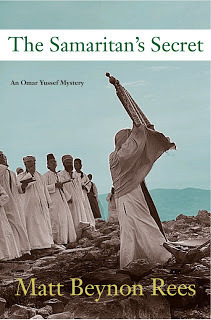
I'm guest-blogger today on Checkpoint Jerusalem, the excellent and delightfully varied blog by McClatchy Newspapers Middle East correspondent Dion Nissenbaum. Dion does a better job of rooting out interesting cultural angles on the news than anyone else covering the Middle East. Under the headline "Jesus was Right: Finding a Good Samaritan", Dion introduces my series of Palestinian crime novels and then posts this contribution from me:
It turns out Jesus was right.
I know, because I found a Good Samaritan.
Really, he was a good guy, and he actually was a Samaritan. There are still a few of them about.
In January, my new Palestinian crime novel, The Samaritan's Secret, was about to be published.
The story unfolds on a West Bank hilltop where the last remnants of the ancient Samaritan tribe live.
There are just 370 of them, high above the violent city of Nablus, near the site where they believe their ancient Temple stood.
To help my readers get a sense of the place, I decided to film a video clip using many of the locations from the book.
My friend, videographer David Blumenfeld. and I headed from our homes in Jerusalem to shoot the video.
The day before, I had spoken with a Samaritan priest to arrange some meetings and to be sure the enclosure around the Temple wouldn’t be locked.
“That depends on the money,” he said, in Hebrew. (The Samaritans mainly speak Arabic, but they also have Israeli ID cards and speak Hebrew. On their Sabbath, they speak nothing but Samaritan, which they believe is true ancient Hebrew.)
As a journalist, I’m not accustomed to paying to interview people.
“How much?” I asked.
“How much do you think?” he ventured.
Oh, no, we’re about to get all Middle Eastern, I thought. I hate haggling.
“Well, let’s say 200 shekels.” That’s about 60 bucks.
He scoffed.
“A thousand.”
I made groaning noises to show that such a figure was painful to me.
“Five hundred.”
“Five hundred,” he said. “See you tomorrow.”
When we reached the village, Kiryat Luza, the day was clear and sunny. The priest met us at the museum -- which he set up some years ago in his living room -- and we filmed a few scenes alongside his trove of photos and old documents.
Before we’d finished, he took out a receipt book: “I’ll do your receipt, shall I? What did we say? A thousand, wasn’t it?”
“No, it was five hundred.”
He started to tell me about how much work we were making him do. I gave him seven hundred and let it go.
Now, the priest was supposed to open the gates to the Temple compound for us. But somehow, after I’d paid him, that duty was delegated to another fellow.
As we filmed, the new guy complained that he needed to go home and eat. (The Samaritan village is about the sleepiest place I’ve ever seen. If anybody up there had anything pressing to do that necessitated hurrying me along, I’d have been very, very surprised.)
So, as we left, I gave him 100 shekels [about $25 US:] and thanked him with my warmest collection of Arabic words of praise.
“Something for the other guy?” he said, pointing at a figure lurking near the gate. “He had to wait too.”
I peeled off 20 shekels more. I hadn’t been squeezed this badly since I was first in the Middle East as an innocent 19-year-old backpacker, shucked for “baksheesh” by every Egyptian within a mile of the Great Pyramid.
David and I had filmed for four hours in a ridiculously hot January sun. I had read my cue-cards in five different languages, and I’d been fleeced until the leather on my wallet started to look raw. Sustenance was in order.
We went down the slope to the village to look for food.
There are only two establishments in the Samaritan village that in any way resemble eateries. “The Good Samaritan Restaurant” would’ve been the best bet, you’d have thought. But it serves no food -- only whiskey.
Next door, the “Guests and Tourists Paradise” was open. Three men smoked cigarettes lazily at one of the tables.
“Is it possible to eat?” I asked.
A tall, thin young man rose and welcomed us. We took a couple of Cokes from the fridge and sat. There was much muttering among the three smokers. Two of them disappeared up the street.
“I think they’ve gone home to ask Mamma to make our lunch,” I said to David.
Certainly no cooking took place in the kitchen at the back of the restaurant. The tall man smiled and nodded.
“No problem,” he said. “Food is coming.”
We waited... and waited... for half an hour. But the food did come, and it was good.
As we left, the young man told me his name was Samih. His father was the High Priest of the Samaritans. He gave me a free poster with historical information about the Samaritans and smiled very broadly.
Then he counted out my exact change.
I left a nice tip.
Published on April 28, 2009 05:58
•
Tags:
arab, arabic, east, good, hebrew, jesus, jew, mcclatchy, middle, nablus, newspapers, palestine, palestinians, samaritan, samaritans
The Writing Life: Warwick Collins
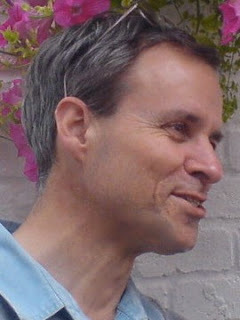
The riskiest thing for a writer to do is to try to enter the head of a great genius by making that genius the narrator of a novel. Why? Because if you aren’t a genius of at least similar proportions, it won’t ring true. Think of the tedious melodrama that passed for the life of Michelangelo in “The Agony and the Ecstasy”. When that genius is the greatest writer of all time, the risk to our present writer increases proportionally. Warwick Collins, a British novelist and poet, took that chance when he made William Shakespeare the narrator of his novel The Sonnets. But it was worth it, because Warwick succeeded and The Sonnets is by far the most beautiful novel of recent years. It’s also an astonishing examination of why a writer writes and of how a literary work can change along with the life and loves of the writer. That makes Warwick the perfect author to answer the questions posed here in The Writing Life. He has some surprising ideas.
How long did it take you to get published?
I was fortunate that my first book, a sailing thriller called Challenge, was bid for by eight publishers. It was eventually published by Pan/Macmillan
Would you recommend any books on writing?
I don’t know any books on writing that I would recommend. The best way to learn about writing, I suspect, is to read as much good literature as one can.
What’s a typical writing day?
I’m one of those annoying people who feel fresh when they wake up, so I try to put in a minimum of one and a half hours before breakfast. If I feel up to it, I’ll return at various stages in the day. But I find writing is quite a nervous and energy-sapping process, and often I find that after my morning efforts I need the rest of the day to recover and be ready for the next early morning attempt on the blank screen.

Plug your latest book. What’s it about? Why’s it so great?
My most recent novel The Sonnets is an attempt to describe Shakespeare’s life from 1592-4, the years in which the London theatres were closed by threat of plague, and the 29-year-old Shakespeare was forced back on his own resources. He was fortunate to find a patron in the young Earl of Southampton. Those were the years in which many of the other playwrights died of violence (like Marlowe, killed in suspicious circumstances in a pub or Kyd, put on the rack) or of poverty, like Greene. Shakespeare emerged from those turbulent times to become the leading playwright on the Elizabethan stage. During those plague years, too, it is widely believed that Shakespeare wrote the bulk of his great sonnet sequence. I’ve integrated 32 full length sonnets into the text of my novel. I also added two “imitation” sonnets – both carefully flagged up as imitations, by the way. It was fascinating attempting to compose those imitation sonnets, and I think it helped me to gain an insight into the way sonnets are constructed, and how the very tightly defined form imposes on the content.
How much of what you do is formula dictated by the genre within which you write, and how much is as close to complete originality as it’s possible to get each time?
So far I’ve always been criticized by UK and American corporate publishers for NOT writing to a formula and for constantly changing both the subject matter and the style with which it is approached.
Who’s the greatest stylist currently writing?
For prose, Cormac McCarthy; for dialogue, Elmore Leonard.
Who’s the greatest plotter currently writing?
Philip Pullman, for His Dark Materials trilogy.
How much research is involved in each of your books?
I thoroughly recommend writing the first draft of the book before one does detailed research. This appears the wrong way round, but I believe it is still vastly more effective. Knowing the subject matter of the novel greatly narrows the research area, and the result is that the research in that area can be highly focused and detailed. The Rationalist and The Marriage of Souls were both set in the eighteenth century, about which I knew very little. I could have spent years reading up about the eighteenth century and only used a fraction of my laboriously acquired knowledge in the novels. But, for example, once I knew that Silas Grange, the protagonist, was a physician of “modern” outlook (for the times), I could research the area of medical practice in far greater depth than otherwise would have been the case, and virtually all of it was useful.
Where’d you get the idea for your main character?
A number of writers I have talked with are inspired by people whom they’ve met. In my own case, I get interested in an idea first, and after that it’s more a matter of trying to build up a character from the circumstances. In the case of The Rationalist, for example, some of the few things I did know about the eighteenth century were that it was a time of loss of religious faith, of the rise of science, and the loosening of sexual mores – in that way a reflection of our own times. It seemed interesting to me if Grange had elements of a modern scientist in his character, was perhaps a touch obsessive, pragmatic, rational, thorough, and if the femme fatale who brought him down, Mrs Celia Quill, was something of a proto-feminist.
What’s your experience with being translated?
So far pretty good. I’ve been fortunate that my foreign language publishers have chosen good translators.
Do you live entirely off your writing? How many books did you write before could make a living at it?
I have lived mostly off my writing for about 20 years, but I’m unusual in that most of my income has come from foreign language translation/publication, and from occasional forays into screenwriting.
How many books did you write before you were published?
My first published work was a series of poems published in the magazine Encounter. I wrote two novels before Challenge was published. They both seem to me now to be somewhat juvenile, and I would have no interest in either of them being published.
What’s the strangest thing that happened to you on a book tour?
During a tour of Germany for the German edition of my novel Gents, my publisher was based in Munich. Gents is a novel about three immigrant West Indians who run a urinal in London, and spend much time trying to suppress the “cottaging” (sexual activity between men) which goes on in the cubicles. Each of the West Indian main characters is religious and something of a family man, too, so this background activity is somewhat shocking to them. Although I am not gay myself, Gents was fortunate to receive favorable reviews from the gay press, and from West Indian reviewers. I don’t know whether my German publisher, a leading feminist, was being mischievous, but while on book tour she booked me in at a famous gay hotel in Munich. That was a very interesting experience.
What’s your weirdest idea for a book you’ll never get to publish?
The weirdest idea I have had for a book was Gents, and I did publish it, and am glad that I did.
April 26, 2009
The Writing Life: Evan Fallenberg
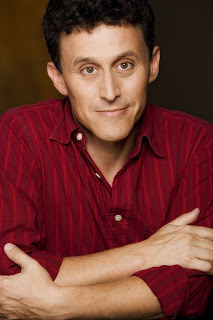
The most stirring, dramatic novel I’ve read in many years is Light Fell by Evan Fallenberg. It’s the story of Joseph Licht, an Israeli family man who falls in love with his rabbi. At first it looks like it might be the tale of their forbidden romance, but the book takes a startling turn and Licht is forced to face the religious beliefs, prejudices, and resentments of his sons. Light Fell has won or been shortlisted for: the Barbara Gittings Stonewall Award; a National Jewish Book Award; the Edmund White Award; and a Lambda Literary Award. Fallenberg's also one of the leading translators of Hebrew literature, including Batya Gur's Murder in Jerusalem, Alon Hilu's Death of a Monk, and Meir Shalev's A Pigeon and a Boy, winner of the 2007 National Jewish Book Award for fiction and a finalist for the PEN Translation Prize. A proud native of Cleveland, Ohio, Evan lives in a rural community near Netanya, Israel, where he runs a writing school in his back yard. I wish you could hear him read from his work, because he’s a compelling, engaging presence—go and hear him if you get a chance. Meanwhile, here are his fascinating thoughts on writing.
How long did it take you to get published?
That was a long, protracted process that would look like a mountain range if it were mapped out. Several years, really.
Would you recommend any books on writing?
For teaching I mostly rely on Writing Fiction by Janet Burroway; Creating Fiction, edited by Julie Checkoway; Pat Schneider's Writing Alone and with Others; and What If? by Pam Painter and Anne Bernays. As a writer I've been enriched by writing books penned by Jane Smiley, Francine Prose, and especially Ben Yagoda (The Sound on the Page) and, the best of them all, EM Forster's Aspects of a Novel.
What’s a typical writing day?
I only learned what my typical writing day was a few years ago, when I was a guest artist at the MacDowell Colony and my days were entirely my own. Until then it had simply been a matter of finding an hour when no spouse, boss, child or chore needed me. But when able to choose, I like to rise early, write a scene or two, eat a hearty breakfast, take a mid-morning nap, and settle down to work again for a long stretch from noon until dinner.
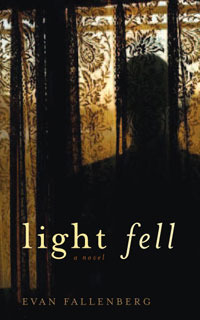
Plug your latest book. What’s it about? Why’s it so great?
Light Fell is the story of Joseph Licht, an Israeli who in 1976 leaves a life of certainties (wife, children, religion, a position in society and academia) for a great and forbidden love with a dynamic young Orthodox rabbi. Since it's impossible to offer credible, objective (!) feedback on one's own book, I'll quote the judges of the American Library Association's Barbara Giddings Stonewall Award, who awarded their fiction prize to Light Fell this year: "With rich characterization and eloquent writing Fallenberg explores the inner lives of a family and the universal applicability of the social and religious issues they face." For me as a reader, books need to have engaging characters of depth taking part in a gripping story that I can relate to no matter how different my life is to theirs, and written in language that is at the same time rich, precise and unselfconscious. The judges' comment makes me feel as though I have succeeded in writing book that even I would like to read!
How much of what you do is dictated by a genre?
I certainly don't fit into any genre that I know of. Writing, for me, feels like reinventing the wheel every time. But I wouldn't want it any other way. After all, if you are just writing an altered version of what someone else has already done, why bother?
What’s your favorite sentence in all literature, and why?
The closing lines of a poem by the Mexican poet Amado Nervo:
Amé, fuí amado, el sol acarició mi faz.
¡Vida, nada me debes! ¡Vida, estamos en paz!
(I loved, I was loved, the sun stroked my face.
Life, you owe me nothing! Life, we are at peace!)
I learned this poem by heart when I was twelve or so. Back then it was just a jumble of pretty words in Spanish. But it has come to feel like a motto for life, one I believe in every day and hope to do so to my very last.
What’s the best descriptive image in all literature?
There is certainly no one best descriptive image, but the one that jumps to mind (and does so quite often) is from Carson McCullers' short story The Sojourner, which made a huge impression on me many many years ago: "Fair Elizabeth, rosy and naked before her bath. Half-dressed before the mirror of her dressing table, brushing her fine, chestnut hair. Sweet, casual intimacy, the soft-fleshed loveliness indisputably possessed." It's that 'soft-fleshed loveliness indisputably possessed' that gets me every time.
Who’s the greatest plotter currently writing?
Probably Lionel Shriver, an American-born writer living for many years in London. Her book The Post-Birthday World is a masterpiece. Every time she took me to a new plateau I thought I'd reached the summit, but there was always more.
Who’s the greatest stylist currently writing?
I'll go with British writer Michael Frayn, since he is capable of brilliance in every genre he tries: theater, nonfiction, novels.
How much research is involved in each of your books?
The research is great fun, and I could get carried away with it. The book I'm working on now 'required' me to travel to Warsaw, Copenhagen and Berlin AND take ballet lessons. Maybe my next book should involve a Tahitian beach, somehow.
What’s your experience with being translated?
In my case, the question should read "What's your experience with translating?" since that is my vocation. I've had the privilege and pleasure of translating some very fine Israeli writers, including Meir Shalev, Ron Leshem, Batya Gur, Alon Hilu… Every book is an act of ventriloquism, trying to find a voice that isn't your own but isn't exactly the writer's either, since you're rendering this voice in a new language (and culture). My goal is to provoke the same reactions in the English reader that the Hebrew reader would have experienced when reading the original. But the art of translation is imperfect from the outset. The biggest compliment for me came from a reader of my translation of Meir Shalev's A Pigeon and a Boy, who told me she felt as though Meir Shalev had actually written this book in English.
Do you live entirely off your writing? How many books did you write before could make a living at it?
At this point I could only live off my writing by building a tent out of book covers and eating all the pages. But I do actually make my living from a mix of writing, translating and teaching creative writing. So I live off words, that's for sure.
How many books did you write before you were published?
I'm one for one. Nothing in my drawers!
What’s the strangest thing that happened to you on a book tour?
Between two speaking engagements in my native Ohio I was to be interviewed by the local affiliate of National Public Radio. They needed me to be on a landline just when I had planned to visit my sister at the restaurant she owns, but the only quiet place was her office, which doubles as a storeroom. I stood there among huge cans of tomato sauce trying to sound cool and intelligent while the fax machine kept ringing and employees banged at the door looking for waffle batter.
What’s your weirdest idea for a book you’ll never get to publish?
I have a dream of collaborating with a composer-friend on a novella set to music, a sort of mini-opera in four voices. I'm hoping it's just crazy enough to happen.
April 23, 2009
The Writing Life: Thomas M. Kostigen
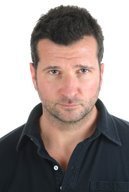
Thomas M. Kostigen is the most important environmental writer in the U.S. That’s not only because he’s trekked through the Amazon to record how we’re destroying it, or because he climbed into the Fresh Kills landfill on Staten Island to…smell how badly it stinks. Or because his ground-breaking New York Times bestseller The Green Book gave us all a checklist for ways to improve the environment around us. It’s also because when he writes about these vital issues he does it with a vibrant touch that brings a sometimes dry scientific and political issue to life. For this reason – if not also for the diversity of his writing experience, as a financial writer, playwright, and screenwriter -- I asked the Santa Monica-based Kostigen to talk about The Writing Life.
How long did it take you to get published?
I actually started writing in college. I interned at a local newspaper that happened to win the Pulitzer Prize while I was working there. So I had these great clips to go along with my degree. From there, well, I continued to publish in newspapers, magazines and wire services. I ghost-wrote a couple of books in my early twenties. I also wrote some plays that were produced, a film, and then turned to books. My first book came a decade after college.
Would you recommend any books on writing?
I think Syd Field's book on screenwriting applies to all writing forms because it's about process, structure and tenacity. But really the best books are authors' memoirs or autobiographies.
What’s a typical writing day?
I write every day. Every day! Usually I get informed in the morning. By that I mean reading a lot of newspapers, blogs, and the wires. This helps me wake up and usually sparks an idea or two. I'm an early riser, so by 8 a.m. I am a pot of coffee into the day and cranking away at my quota. I aim for a thousand words a day.
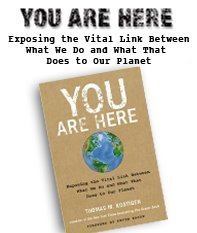
Plug your latest book. What’s it about? Why’s it so great?
My latest book is entitled You Are Here: Exposing the Vital Link Between What We Do and What That Does to Our Planet. I traveled around the world to very exotic locales to research how we affect the planet by the simple, everyday things we do in our lives. It's great because it's an adventure story as well as a book that has information that can change the world for the better.
How much of what you do is completely original?
I write nonfiction. And while I try to write in my own unique voice, I do rip off Bowles, Theroux, and Chatwin...
What’s your favorite sentence in all literature, and why?
"For sale: baby shoes, never worn." Hemingway wrote that as supposedly his shortest, short story. And he thought it his best work, or so it's said. Anyway, I like it.
What’s the best descriptive image in all literature?
I think John Irving's description of Owen Meany is up there. He made me hear Meany's voice. Quite a feat for a writer...
Who’s the greatest stylist currently writing?
I'd have to give that to DeLillo. His rhythm is unmatched, and he really shades things nicely.
Who’s the greatest plotter currently writing?
Rushdie. Who can think like that?
How much research is involved in each of your books?
As a nonfiction writer, I put an enormous amount of research in everything. (I have to footnote.) Memoir editors take note.
What’s your experience with being translated?
I've been translated into about a dozen different languages. My only problem is with Chinese grammar. (They never get it right!) I also learned that my last name in Swedish means "cow path." Hmm....
Do you live entirely off your writing? How many books did you write before could make a living at it?
I've actually always lived solely off my writing. Now, I live off my books and my freelance journalism. I started making real money after one of my books hit the New York Times best seller list. That moniker gives you lots of cred.
How many books did you write before you were published?
I finished two full manuscripts before I got anything published by a house.
What’s the strangest thing that happened to you on a book tour?
Ah. Funny story. I was met by my author escort at the airport. She looked exactly like Kathy Bates in Misery. She had double parked her junk car at the sidewalk and got a ticket. An old pizza box was on the passenger seat, which she cleared for me to sit on. After the death ride to my first talk, I came out to find her -- and she had gone. Never saw her again. Crazy.
What’s your weirdest idea for a book you’ll never get to publish?
The History of the Pogo Stick.
Published on April 23, 2009 22:28
•
Tags:
environment, kostigen, life, writers, writing
What's the difference between Sharansky and Lieberman? Apart from a few inches, not much
By Matt Beynon Rees, published on Global Post
JERUSALEM — So, there are two eastern European guys, one from Ukraine and the other from Moldova.
One of them is on the short side and is a chess whiz who suffered through a Siberian labor camp for his uncompromising belief in democracy and freedom. Meet Natan Sharansky, who was picked this weekend by Israeli Prime Minister Benjamin Netanyahu to lead the Jewish Agency for Israel.
The other is a beefy former nightclub bouncer who says nasty things about Arabs and is generally seen as just plain uncompromising. Meet Foreign Minister Avigdor Lieberman, who, it’s fair to say, is feared and loathed as a hardliner.
The two men couldn't carry themselves more differently and you don't have to be a longtime observer of Israel to know which one fits in better with the western diplomatic community and is most favored by America.
Trouble is they’re essentially the same guy.
Both reflect something unbending in current Israeli political thinking. But international diplomats will make a mistake if they ignore the reality signaled by the popularity of these two politicians and its consequences for the peace maneuvers that got underway this last week.
Sharansky pulled out of former prime minister Ariel Sharon’s government in 2005 to protest the Israeli withdrawal from its Gaza settlements and has since been occupying an office in a right-wing think thank in Jerusalem — when he hasn’t been touring the U.S. on high-paying speaking gigs.
Lieberman, meanwhile, lives in a settlement, drove his party to third place in the country’s February election with a promise of imposing a loyalty oath on Arab citizens of Israel, and, in his first statement as foreign minister, said "If you want peace, prepare for war."
That classically Lieberman aphorism prompted gritted teeth at the State Department, which sent special envoy George Mitchell to Ramallah and Cairo recently to prepare the U.S. plan for handling the new Israeli government.
But in their different ways, Sharansky and Lieberman are both saying the same thing: Israelis are tired of being pressured to hand over land to Palestinians, while the Palestinians ignore the world’s polite requests for an end to terrorism.
When I met with Sharansky just after he resigned from the cabinet in 2005, he explained what he had told Prime Minister Sharon when he went to his office to quit.
“One-sided concessions by us leave the Palestinians with their problems,” he said. “It’s an illusion to think international pressure on us will stop when we make concessions. We’re making terrorism legitimate. We dismantle settlements, terror continues, and the world will say we just didn’t dismantle enough.”
That’s how most Israelis tend to see things these days. (If you don’t believe that, check out the election results and witness the disappearance of the so-called left-wing parties.) And Sharansky's position is remarkably close to that of Lieberman. For example, instead of simply giving up the West Bank to the Palestinians, Lieberman has said that Israel ought to keep some of its settlement blocs and, in return, hand over parts of Israel where its Arab population lives to a new Palestinian state.
For Israelis, that would give them a sense of having driven a good bargain and received something in return for their concessions.
Western observers may not see things that way, but now they know what Israelis think. And Israelis are the ones that count.
So maybe we need to look for the difference between the two men for a hint of how we ought to interpret their positions.
The answer: democracy.
Sharansky, 61, wrote “The Case for Democracy” in 2004. It was a favorite of George W. Bush. It argued that the dictatorial Arab regimes couldn’t make peace with democratic Israel — totalitarian regimes need an enemy to demonize. The west needed to make the Arab countries democratic, instead of bolstering dictators.
We all like democracy, of course. So thumbs up for Sharansky, whose book went onto The New York Times bestseller list.
Lieberman, on the other hand, is generally portrayed as rather Stalinist in his approach to dissent and minorities. That earns him the Bronx cheer from the media.
The thing to remember is that it also earned him 15 seats in the parliament, leadership of the second-biggest party in the new coalition government, and the foreign minister’s chair.
Sharansky, by contrast, is being nominated to lead a body whose main function in these days of falling immigration is to encourage Jews in the diaspora to remain connected to their community. (Jewish Agency officials fear the dwindling population of Jews worldwide through intermarriage, and cite 50,000 new “former Jews” each year around the world due to assimilation.)
The former dissident Sharansky will be the lovable face of Israel’s new tough line and may even make it to the (ceremonial) president’s mansion in a few years. But it’s Lieberman who wields power.
JERUSALEM — So, there are two eastern European guys, one from Ukraine and the other from Moldova.
One of them is on the short side and is a chess whiz who suffered through a Siberian labor camp for his uncompromising belief in democracy and freedom. Meet Natan Sharansky, who was picked this weekend by Israeli Prime Minister Benjamin Netanyahu to lead the Jewish Agency for Israel.
The other is a beefy former nightclub bouncer who says nasty things about Arabs and is generally seen as just plain uncompromising. Meet Foreign Minister Avigdor Lieberman, who, it’s fair to say, is feared and loathed as a hardliner.
The two men couldn't carry themselves more differently and you don't have to be a longtime observer of Israel to know which one fits in better with the western diplomatic community and is most favored by America.
Trouble is they’re essentially the same guy.
Both reflect something unbending in current Israeli political thinking. But international diplomats will make a mistake if they ignore the reality signaled by the popularity of these two politicians and its consequences for the peace maneuvers that got underway this last week.
Sharansky pulled out of former prime minister Ariel Sharon’s government in 2005 to protest the Israeli withdrawal from its Gaza settlements and has since been occupying an office in a right-wing think thank in Jerusalem — when he hasn’t been touring the U.S. on high-paying speaking gigs.
Lieberman, meanwhile, lives in a settlement, drove his party to third place in the country’s February election with a promise of imposing a loyalty oath on Arab citizens of Israel, and, in his first statement as foreign minister, said "If you want peace, prepare for war."
That classically Lieberman aphorism prompted gritted teeth at the State Department, which sent special envoy George Mitchell to Ramallah and Cairo recently to prepare the U.S. plan for handling the new Israeli government.
But in their different ways, Sharansky and Lieberman are both saying the same thing: Israelis are tired of being pressured to hand over land to Palestinians, while the Palestinians ignore the world’s polite requests for an end to terrorism.
When I met with Sharansky just after he resigned from the cabinet in 2005, he explained what he had told Prime Minister Sharon when he went to his office to quit.
“One-sided concessions by us leave the Palestinians with their problems,” he said. “It’s an illusion to think international pressure on us will stop when we make concessions. We’re making terrorism legitimate. We dismantle settlements, terror continues, and the world will say we just didn’t dismantle enough.”
That’s how most Israelis tend to see things these days. (If you don’t believe that, check out the election results and witness the disappearance of the so-called left-wing parties.) And Sharansky's position is remarkably close to that of Lieberman. For example, instead of simply giving up the West Bank to the Palestinians, Lieberman has said that Israel ought to keep some of its settlement blocs and, in return, hand over parts of Israel where its Arab population lives to a new Palestinian state.
For Israelis, that would give them a sense of having driven a good bargain and received something in return for their concessions.
Western observers may not see things that way, but now they know what Israelis think. And Israelis are the ones that count.
So maybe we need to look for the difference between the two men for a hint of how we ought to interpret their positions.
The answer: democracy.
Sharansky, 61, wrote “The Case for Democracy” in 2004. It was a favorite of George W. Bush. It argued that the dictatorial Arab regimes couldn’t make peace with democratic Israel — totalitarian regimes need an enemy to demonize. The west needed to make the Arab countries democratic, instead of bolstering dictators.
We all like democracy, of course. So thumbs up for Sharansky, whose book went onto The New York Times bestseller list.
Lieberman, on the other hand, is generally portrayed as rather Stalinist in his approach to dissent and minorities. That earns him the Bronx cheer from the media.
The thing to remember is that it also earned him 15 seats in the parliament, leadership of the second-biggest party in the new coalition government, and the foreign minister’s chair.
Sharansky, by contrast, is being nominated to lead a body whose main function in these days of falling immigration is to encourage Jews in the diaspora to remain connected to their community. (Jewish Agency officials fear the dwindling population of Jews worldwide through intermarriage, and cite 50,000 new “former Jews” each year around the world due to assimilation.)
The former dissident Sharansky will be the lovable face of Israel’s new tough line and may even make it to the (ceremonial) president’s mansion in a few years. But it’s Lieberman who wields power.
April 21, 2009
Review: Haitian scandal, voodoo and family obsession with Cara Black
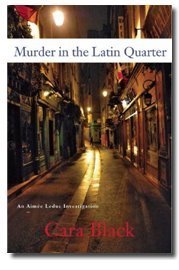
Murder in the Latin Quarter
by Cara Black
Soho Crime, isbn 1569475415
Just when our detective is set to get down to some normal, profitable work, a woman walks into her office with a story that sets our mystery on a personal track. It’s a tested opening for a detective novel, but Cara Black’s version of it has an originality and freshness that works well. The detective is Aimée Leduc, a Parisian computer-security expert, and the mystery woman is an illegal Haitian immigrant who claims to be Leduc’s half-sister. On her first attempt to get more details from the supposed sister, Leduc discovers the murdered body of a Haitian scientist and realizes that the newcomer may be involved in something more than family genealogy.
The ninth episode in Black’s series of Paris detective novels takes Leduc through a plot involving voodoo, corrupt businessmen, and scandal in Haiti. But it remains rooted in the streets of Paris. Leduc ends up crawling through windows and tunnels, covered in the muck of the City of Light. It’s a good image for the way Black keeps the novels grounded there. Paris may be everyone’s idea of a romantic city, but to those who know it it’s also a place of “diversity”—a nice modern way of saying that there are many awful inequities. “Murder in the Latin Quarter” is a fine way to slap some reality onto those vacation memories and to get a picture of the varied life in the French capital.
As an episode in a lengthy series of novels, there are also intriguing developments in Leduc’s obsession with family--her radical mother abandoned her as a girl, and her policeman father was murdered, so it’s easy to see why she ponders the issue a lot. The possible blood connection to the Haitian woman drives Leduc through the dangers of the book, and by the end it’s clear that the same urge will be eating at her until the welcome arrival of the next novel by Cara Black.
Beastly Me: my Holocaust take on The Daily Beast
I've started writing for Tina Brown's ground-breaking news website The Daily Beast. The first of my pieces runs today. Here's the headline:
ISRAEL'S PRIVATE SHAME
Today is Holocaust Remembrance Day, and the worst place to be a survivor might be Israel.
To read the article, click here.
ISRAEL'S PRIVATE SHAME
Today is Holocaust Remembrance Day, and the worst place to be a survivor might be Israel.
To read the article, click here.
Published on April 21, 2009 09:21
•
Tags:
beast, daily, holocaust, israel, journalism



